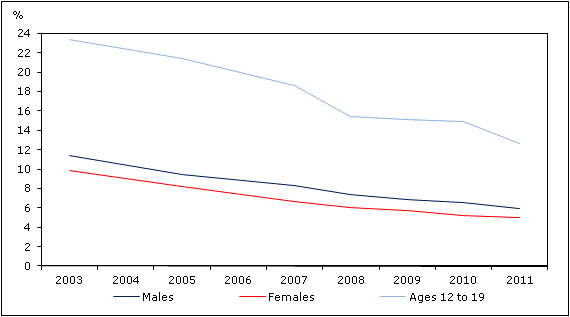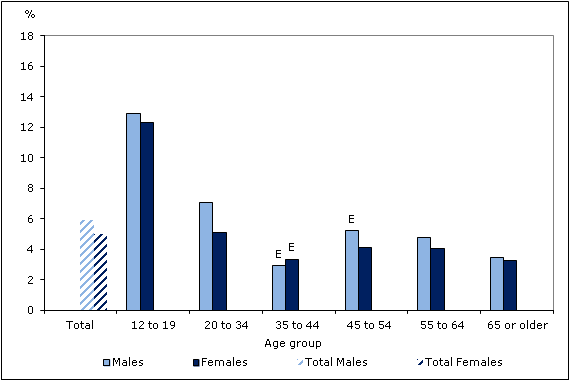Exposure to second-hand smoke at home, 2011
Archived Content
Information identified as archived is provided for reference, research or recordkeeping purposes. It is not subject to the Government of Canada Web Standards and has not been altered or updated since it was archived. Please "contact us" to request a format other than those available.

'Passive smoking,' or exposure to second-hand smoke, has negative respiratory health effects. Two of the most common associated diseases are lung cancer in adults and asthma among children.
The proportion of non-smokers aged 12 and older who were regularly exposed to second-hand smoke at home has declined since 2003, reaching 5.5% in 2011. This rate is unchanged from 2010.
More men than women were exposed to second-hand smoke at home (Chart 1).
In 2011, 12.6% of young Canadians aged 12 to 19 were exposed to second-hand smoke at home — falling from 23.4% in 2003 (Chart 1). This age group is the most likely to be exposed to second hand smoke at home. Of the 1.27 million non-smoking Canadians aged 12+ who were regularly exposed to second-hand smoke at home, the 12-19 year-old age group made up 29.4%.
Chart 1
Percentage of non-smokers regularly exposed to second-hand smoke at home, by sex and selected age group, household population aged 12 or older, Canada, 2003 to 2011

Source: Canadian Community Health Survey, 2003, 2005, 2007, 2008, 2009, 2010, 2011.
In 2011, exposure to second-hand smoke at home was highest among those aged 12 to 19. Men aged 20 to 34 were significantly more likely than women to be exposed to second-hand smoke at home; however, there was no significant difference between the sexes in other age groups (Chart 2).
Chart 2
Percentage of non-smokers regularly exposed to second-hand smoke at home, by age group and sex, household population aged 12 or older, Canada, 2011

Note:
E Use with caution (coefficient of variation 16.6% to 33.3%).
Source: Canadian Community Health Survey, 2011.
Only Ontario (4.8%), Manitoba (4.2%) and British Columbia (2.4%), posted rates of exposure to second-hand smoke at home below the national average. Prince Edward Island (9.0%) and Quebec (8.6%) were above the national average.
References
Shields, Margot. 2007. "Smoking—prevalence, bans and exposure to second-hand smoke." Health Reports, vol.18, no. 3: 67–85. /pub/82-003-x/2006007/article/smoking-fumer/10198-eng.pdf (accessed June 3, 2010)
Pérez, Claudio E. 2004. "Second-hand smoke exposure—who's at risk." Health Reports, vol. 16, no.1, 9–17. /studies-etudes/82-003/archive/2004/7037-eng.pdf (accessed June 3, 2010)
Data
Additional data from the Canadian Community Health Survey are available from CANSIM table 105–0501.
- Date modified:
